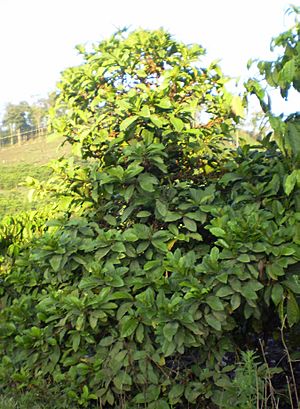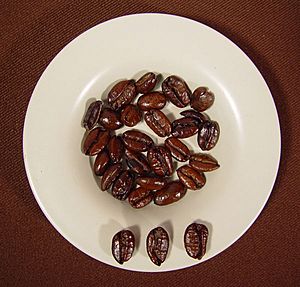Liberian coffee facts for kids
Coffea liberica, also known as Liberian coffee, is a type of flowering plant that gives us coffee beans. It belongs to the Rubiaceae plant family. This coffee tree grows naturally in parts of western and central Africa, including countries like Liberia and Uganda. You can also find it growing in places like the Philippines, Indonesia, Seychelles, the Andaman & Nicobar Islands, and Malaysia.
Quick facts for kids Liberian coffee |
|
|---|---|
 |
|
| C. liberica tree in Vietnam | |
 |
|
| Roasted C. liberica beans from the Philippines, where they are known as "kapeng barako" | |
| Conservation status | |
| Scientific classification | |
| Genus: |
Coffea
|
| Species: |
liberica
|
| Synonyms | |
|
|
Contents
What Makes Liberica Coffee Special?
Tall Trees and Big Beans
Coffea liberica trees are super tall! They can grow up to 20 m (66 ft) high, which is like a six-story building. Because they are so tall, people need to use ladders to pick the coffee cherries.
The cherries, beans, and leaves of Liberica coffee are also very large. They are bigger than most other types of coffee plants.
Unique Bean Shape
The beans from Coffea liberica have a special shape. They look different from other common coffee beans, like Arabica or Robusta. One side of a Liberica bean is shorter than the other. This creates a little "hook" at the tip. The line in the middle of the bean is also more jagged.
Growing and Using Liberica Coffee
A Rare Type of Coffee
Coffea liberica makes up less than 1.5% of all the coffee grown around the world. This means it is quite rare compared to Arabica or Robusta coffee.
It was first grown for business in the Philippines. Spanish friars brought it to the city of Lipa in the 1740s. For a long time, C. liberica was the main coffee type grown in the Philippines. People in Western countries would pay up to five times more for these beans!
Surviving a Plant Disease
In the late 1800s, a plant disease called coffee rust spread worldwide. It destroyed many Arabica and Robusta coffee farms. C. liberica farms in the Philippines lasted longer against the disease. However, they eventually also got sick, which caused the coffee industry there to struggle.
Liberica in the Philippines and Beyond
In the Philippines, C. liberica is known as kapeng barako. It is still very popular and widely grown there, mostly for people in the country to enjoy. Today, the provinces of Batangas and Cavite are the main places where this special Philippine Liberica coffee is grown.
At the end of the 19th century, C. liberica was also brought to Indonesia. It helped replace the Arabica trees that had died from coffee rust. You can still find it growing in parts of Java and West Kalimantan today. Liberica coffee is also grown in Malaysia, especially on the west coast of Johor. This happened because many Javanese people moved to Malaysia in the 1800s. There is even a very rare type of Liberica found in a hidden part of the Amazon rainforest in Guyana.
Cost and Caffeine
Because Liberica coffee is rare and not many farms grow it, its beans can be more expensive. Premium Liberica beans can cost even more.
If you are curious about caffeine, Liberica beans have the lowest amount of caffeine compared to Arabica and Robusta. For every 100 grams, Liberica has about 1.23 grams of caffeine. Arabica has about 1.61 grams, and Robusta has the most, with about 2.26 grams.
How Liberica Coffee is Classified
Sometimes, scientists change how they group plants. Coffea dewevrei, Coffea dybowskii, and Coffea excelsa used to be thought of as separate types of coffee. But in 2006, they were reclassified. Now, they are considered to be the same as Coffea liberica var. dewevrei.
See also
 In Spanish: Coffea liberica para niños
In Spanish: Coffea liberica para niños


